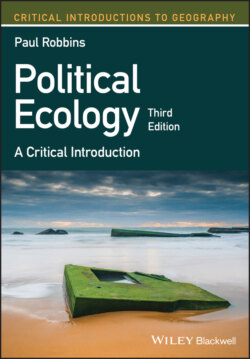Читать книгу Political Ecology - Paul Robbins - Страница 14
The Rest of the Book
ОглавлениеThe remainder of this book directs itself to describing political ecology as a set of grounded arguments, attempting to show what makes political ecology researchers tick, what makes their work urgent to them, and what useful lessons they have provided for addressing important questions.
In Part I, I describe how political ecology came to be the way it is, with its inherent possibilities and limits. Chapter 1 introduces the term political ecology, distinguishing it from apolitical ecologies of various kinds, and showing a unity of practice amidst much diversity of thought. Chapter 2 reviews the deep roots of this line of inquiry, arguing that political ecologists have been around a very long time. Chapter 3 describes the historical development of a critical science of the environment, showing the disparate fields and eclectic tools that converged in the last three decades of the twentieth century to give greater analytical form to the field. This chapter is dense with history and referencing, but is intended to be a source to which the reader can return. Chapter 4 draws this opening section to a close to stress the common character of diverse political ecological texts: they stress winners and losers, are narrated with dialectics, begin or end from contradictions, and stress simultaneously the politicized state of the environment and the politicized nature of accounts about the state of the environment.
The three chapters in Part II review challenges to the field from a range of sources. Chapter 5 examines challenges from ecology, and the question of environmental change as environmental degradation or destruction, while Chapter 6 attends to challenges in the way researchers have considered the environment to be imaginary or constructed. Chapter 7 examines other approaches to nature/society study, including those in “land change science” and those from the perspective that stresses “causal” explanation. These approaches are shown to provide useful, indeed critical, lessons for political ecology, while at the same time they continue to reflect and reinforce some problems political ecology has evolved to address.
Part III examines five central theses of political ecological research, each in its own chapter, which I describe as degradation and marginalization (Chapter 8), conservation and control (Chapter 9), environmental conflict and exclusion (Chapter 10), environmental subjects and identity (Chapter 11), and political objects and actors (Chapter 12). The case materials in each chapter are selected to represent a range of research regions across the world, including cases from the “developed” and “underdeveloped” worlds. The biases of my training and experience will be evident throughout. The research described comes predominantly from the discipline of geography, though it is coupled with work in environmental history, development studies, anthropology, and sociology. While I have tried to include examples from both the global north and south, including cases from North and South America, Africa, and Asia, I have mentioned little of Western or Eastern Europe or of Australia. Research and theory in English predominates in the volume, despite the strong parallel threads of continental European political ecology (Whiteside 2002; see also the volume in French by Gautier and Benjaminsen 2012). Referencing of North American work outweighs that from other places. Finally, numerous international case examples were cut in final editing, owing to a lack of space.
Each of the chapters in this section also includes case histories of how, in my own work, I have tried to do research, and how on many occasions I have been tripped up by hidden pitfalls. These sections only reflect what I have done in research rather than what political ecologists have done more generally, but I think my methodological choices are not unique and the problems I have faced are common not only to political ecology, but also to much research in general.
The conclusions in Part IV will critically evaluate the status of the field and point to ways political ecology can expand and improve. My central argument here is that political ecology must attend to the future, by imagining new alternatives based either on the promises of degrowth or on a kind of emancipatory and modest modernism, all the while breaking loose from both the apocalyptic and green utopian imaginaries that otherwise hold the future captive.
Scattered throughout the text are boxed critical summaries of important individual contributions to political ecology and the people who made them. These are based on my own reading, but wherever possible these also include direct reflections and responses from those authors kind enough to provide them.
The sum of the effort can only be said to give the reader a “feel” for a field of practice that certainly has come to be influential and whose reach has crossed many social and environmental sciences. Curiously, however, for a field of this stature, it seems odd that political ecology is so hard to define! We first must attend to why this might be so.
